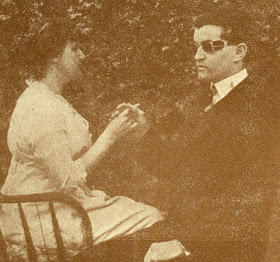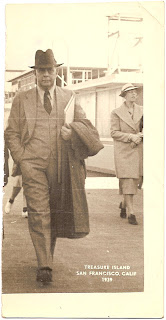In
learning a bit about the teacher who stood behind blind
and deaf
Samuel Bean’s success in high school, we are reading about a
determined and energetic woman. Mary White Eastman, though blind herself, was
not about to allow any deterrent to keep her from achieving what she felt were
vital goals.
Not only was Miss Eastman a strong influence during Sam’s
school years at the California School for the Deaf and Blind in Berkeley,
California, but she devoted hours to related causes. A brief article in the Oakland
Tribune on
September 26, 1916, revealed
her additional involvement on behalf of the blind:
The San Francisco Association for the Blind has
added a [house] teaching department under the direction of Miss Mary White
Eastman. Instruction will be given free to all blind or partially blind who
want to become familiar with systems and appliances used by the blind. Classes
will be held Wednesday afternoons at 1516 California street, San Francisco.
The amount of effort it must have taken to enable Sam to
achieve what he did during his school years provides an idea of the level of
commitment of this teacher—and that was regarding just
one pupil. It seems this work with the blind—and, in Sam’s case,
the deaf—was not merely a job for this forward-thinking woman; it was a life’s
mission.
Of course, Mary White Eastman did not operate within an
academic vacuum. She was surrounded by like-minded educators who were advocates
of the very values she advanced. The California
School for the Deaf and Blind, located
in Berkeley,
nearly intertwined with the academic milieu of the nearby University,
benefiting from inspiration from the thought leaders at that institution. One
mathematics professor there, Newel Perry—soon after Sam’s graduation to be appointed
Director of Advanced Studies at the then-separated state School for the
Blind—was a catalyst for the dawning of new opportunities for the blind.
Newel Perry’s paradigm was summarized by fellow professor,
Jacobus tenBroek, speaking at a memorial service after Dr. Perry's passing in 1961:
The new system took
cognizance of the need of the blind for adjustments on the social and
psychological as well as the physical level. It permitted and encouraged them
to strive to render themselves self-supporting. It applied the democratic
principle of individual dignity to an underprivileged class of American
citizens. It guaranteed them a fair measure of independence and self-respect in
the conduct of their lives.
Such values and concepts as these were not the norm at the
turn of the century in which blind Newel Perry had earned his doctorate in
mathematics from the University of Munich—and then could not secure a position
with any institution of higher education back in his homeland. Returning to the
Berkeley area,
he found a more sympathetic public willing to give credence to his
philosophy of increased opportunity for the “handicapped.”
It is within this framework that Sam’s mentor, Mary White
Eastman, also made her mark.
And yet, there were indications that Mary White Eastman might
not have been as well-received by such like-minded leaders as one might have
expected.
In an
interview conducted in 1956 by
Willa Baum, a proponent of oral history, Newel Perry reflected on the many changes at the California School for the Deaf and Blind during the
years of Mary White Eastman’s tenure. Apparently, by the time Dr. Perry had
returned to California
in 1912, the School was in a turmoil following the resignation of its long-time
principal,
Dr. Warring Wilkinson. Among other comments, Newel Perry observed:
Two or three of the
different employees wanted to succeed Dr. Wilkinson. They had some students,
too, who made trouble. There was Miss Mary White Eastman, a blind graduate of
the School, who was a teacher of the blind children, little children, in what
they called an “opportunity group” for retarded children. She was a woman who
had never had any experience or training except that she was naturally a very
good teacher. She was very ambitious and wanted to be made the head of the
blind department….
Whatever her aspirations might have been, Mary White Eastman
did not succeed in being appointed head of the blind department following the
political upheaval at the school. True, she hadn’t, following graduation from
the school herself, pursued any form of higher education, as had others among
her graduating class. You have to remember, though, the overall context of this
time period: not many women of the time—blind or not—attained the
educational level of college graduate, let alone received the advanced
degree of training as had Dr. Perry.
Over the years since Mary Eastman’s graduation from the California School for the Deaf and Blind, though,
many others from the school had accomplished that feat. Several such blind students
were listed by name in the eulogy given at Dr. Perry’s passing in 1961. All of
them, it may be noted, held one other characteristic in common: they were all men.
One other curious fact does present itself in reviewing the
background on this snippet of information about how others perceived Miss
Eastman. Going back to her own graduation from the school, the 1892 article in
the San Francisco
Call named each member of the
graduating class. There, listed right after the entry for Mary White Eastman,
was the name, “
Newell Lewis Perry.”


















